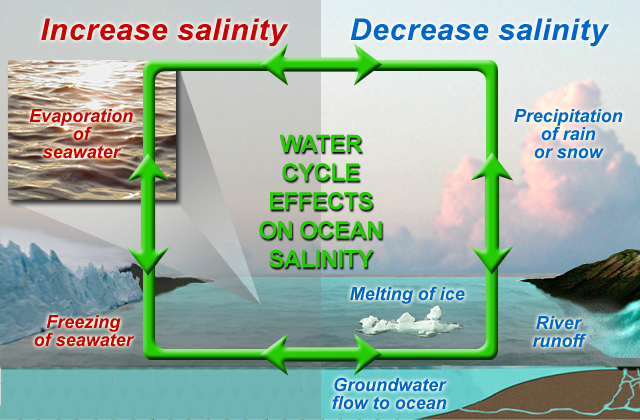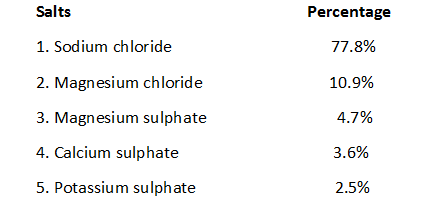
What is the Salinity of the Ocean Water?
Salinity is defined as the total amount of solid material in grams contained in one kilogram of sea water end is expressed as part per thousand.
• The oceanic salinity not only affects the marine organisms and plant community but it also affects the physical properties of the oceans such as temperature, density, pressure etc.
• Variation in salinity causes ocean current.
Composition of sea salt

Sources of oceanic salinity
• Basically the source of oceanic salinity is land.
• Calcium Sulphate constitutes 60%of river salinity while sodium chloride dominates in oceanic salinity.
• River water contains only 2% of sodium chloride.
• Volcanic ashes also provide some salt to the ocean.
Controlling factors of salinity
Evaporation
• There is direct positive relationship between the rate of evaporation and salinity e.g. greater the evaporation, higher the salinity and vice-versa.
• Evaporation due to high temperature with low humidity causes more concentration of salt and overall salinity becomes higher.
• Salinity is higher near the tropics than at the equator because both the areas record high rate of evaporation but with dry air over the tropics of cancer and Capricorn.
Precipitation
• It is inversely related to salinity e.g. higher the precipitation, lower the salinity and vice-versa.
Influx of river water
• Big and voluminous river pour down immense volume of water into the oceans and thus salinity is reduced at their mouths.
Atmospheric pressure and wind direction
• Anti cyclonic conditions with stable air and high temperature increase salinity of the surface water of the ocean.
• Winds drive away saline water to less saline areas resulting into decrease of salinity in the former and increase in the latter.
Circulation of oceanic water
• Ocean currents affect the spatial distribution of salinity by mixing sea waters.
• Ocean currents have least influence on salinity in the enclosed seas.
Distribution of salinity
• The average salinity in the oceans and seas is 35 % .
Horizontal distribution
Latitudinal distribution
• On an average, salinity decreases from equator towards the poles.
• The equator accounts for only 35% salinity which is equal to the average salinity of the oceans and the seas.
• The highest salinity is observed between 200-400N because this zone is characterized by high temperature, high evaporation but significantly low rainfall.
• The average salinity of 35% is recorded between 100 &ndash 300 latitudes in the southern hemisphere.
• The zone between 400-600 latitudes in both the hemispheres records low salinity.
• On an average, the northern and the southern hemispheres record average salinity of 34%0 and 35%0 respectively.
General division
• Equatorial zone (00 &ndash 200) &ndash relatively low salinity.
• Tropical zone (200 -400) &ndash maximum salinity.
• Temperate zone (400- 600) &ndash low salinity.
• Sub-tropical and polar zone (600 -900) &ndash minimum salinity
Vertical distribution of salinity
• Salinity increase with increasing depth in high latitudes.
• The trend of increase of salinity with increasing depths in confined to 200 fathoms from the surface in middle latitudes beyond which it decreases with increasing depths.
Maximum salinity is found in the upper layer of the ocean water. Salinity decreases with increasing depth.
• The upper zone of maximum salinity and the lower zone of minimum salinity is separated by a transition zone called Thermocline zone.
This article is shared by Priyanka Duta. Priyanka is a Guest Lecturer of Geography at New Alipore College, Kolkata.

Join The Discussion